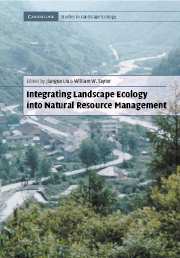Book contents
- Frontmatter
- Contents
- List of contributors
- Foreword
- Preface
- Acknowledgments
- PART I Introduction and concepts
- PART II Landscape structure and multi-scale management
- 2 Integrating landscape structure and scale into natural resource management
- 3 Focal patch landscape studies for wildlife management: Optimizing sampling effort across scales
- 4 Managing for small-patch patterns in human-dominated landscapes: Cultural factors and Corn Belt agriculture
- 5 A landscape approach to managing the biota of streams
- 6 Linking ecological and social scales for natural resource management
- PART III Landscape function and cross-boundary management
- PART IV Landscape change and adaptive management
- PART V Landscape integrity and integrated management
- PART VI Syntheses and perspectives
- Index
- Plate Section
4 - Managing for small-patch patterns in human-dominated landscapes: Cultural factors and Corn Belt agriculture
Published online by Cambridge University Press: 14 January 2010
- Frontmatter
- Contents
- List of contributors
- Foreword
- Preface
- Acknowledgments
- PART I Introduction and concepts
- PART II Landscape structure and multi-scale management
- 2 Integrating landscape structure and scale into natural resource management
- 3 Focal patch landscape studies for wildlife management: Optimizing sampling effort across scales
- 4 Managing for small-patch patterns in human-dominated landscapes: Cultural factors and Corn Belt agriculture
- 5 A landscape approach to managing the biota of streams
- 6 Linking ecological and social scales for natural resource management
- PART III Landscape function and cross-boundary management
- PART IV Landscape change and adaptive management
- PART V Landscape integrity and integrated management
- PART VI Syntheses and perspectives
- Index
- Plate Section
Summary
Introduction
Habitat fragmentation is the nearly inevitable result of contemporary land use. Beyond the biodiversity shadow cast by reserves and habitat protection plans, settlement patterns continue to extirpate remaining habitats. This reality should lead landscape ecologists and natural resource managers to vigorously investigate small patches of habitat. While accumulating knowledge of landscape structure and function leaves no doubt about the critical importance of large indigenous habitat patches, knowledge of the ecological function of small patches is comparatively meager. Yet opportunities for preserving or creating small patches characterize human land use. Informed by landscape ecology, conservation biology, ecosystem management, and restoration ecology, humans have only recently begun to preserve and reconnect the pieces of what were once large, continuous ecosystems. The undeniable trend of contemporary settlement patterns suggests that the small shall inherit the earth. How these small patches can serve ecological functions is a pragmatic question for landscape ecology.
A bird's-eye view of settled landscapes today presents a striking image of the impact of humans on the natural world. The landscape pattern observed is profoundly influenced by culture, created according to political systems, economic uses, aesthetic preferences, and social conventions (Nassauer, 1995). Culture, defined as “the sum total of ways of living built up by a group of human beings and transmitted from one generation to another” (Random House, 1987), not only influences landscape patterns, it can also suggest new landscapes designed to promote ecological function (Nassauer, 1995). New landscape patterns designed without consideration of the appearance of cultural values on the land are not culturally sustainable (Nassauer, 1992, 1997).
Information
- Type
- Chapter
- Information
- Publisher: Cambridge University PressPrint publication year: 2002
Accessibility standard: Unknown
Why this information is here
This section outlines the accessibility features of this content - including support for screen readers, full keyboard navigation and high-contrast display options. This may not be relevant for you.Accessibility Information
- 10
- Cited by
